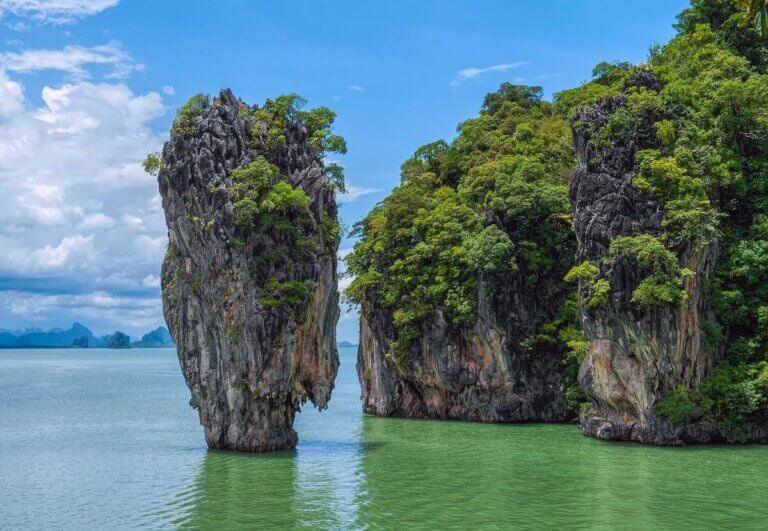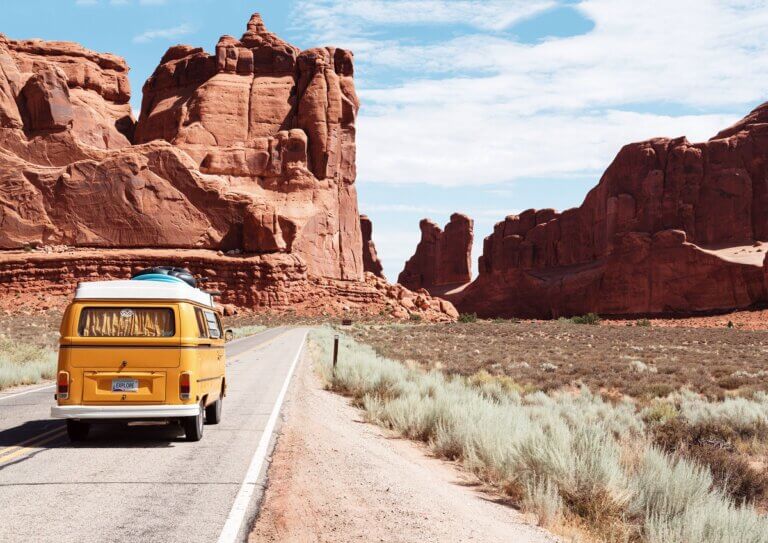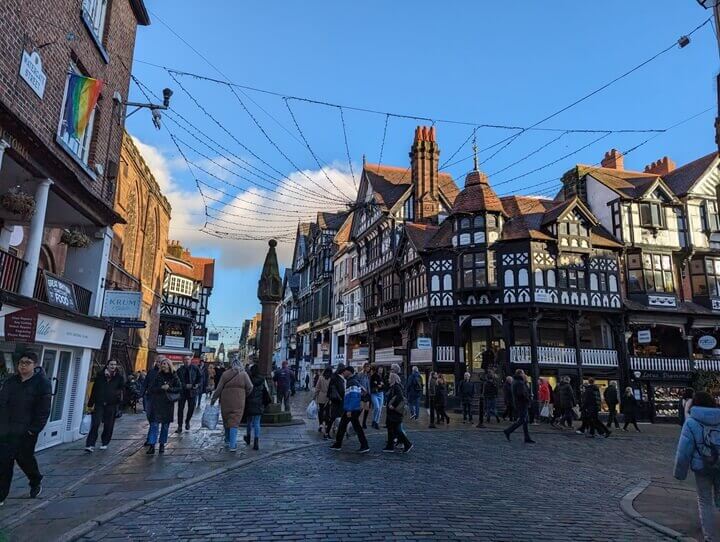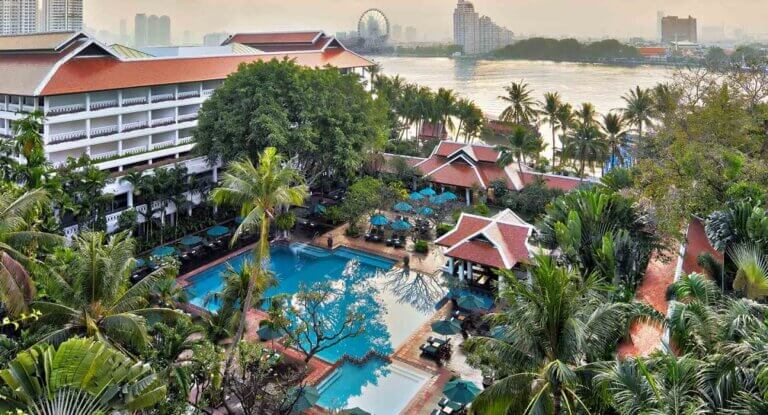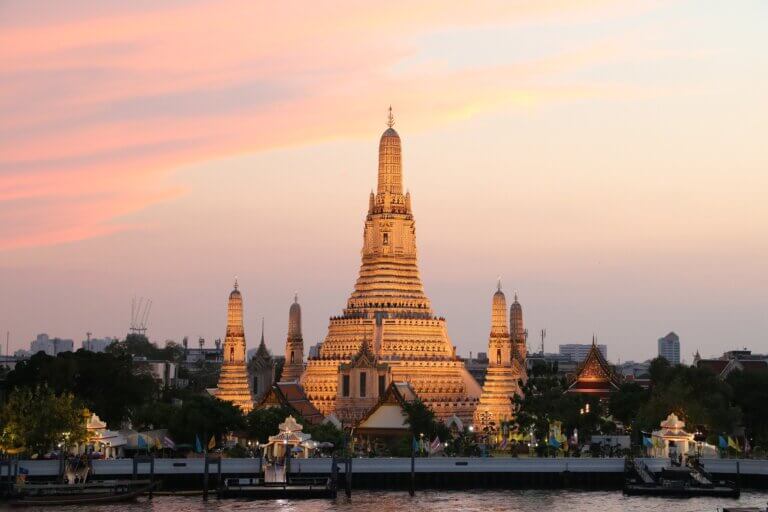What is Thailand Famous for? 23 Things You Need to Know
Wondering what Thailand is famous for? This article will share some of the main things for which the country is known around the world.
Like any other place, Thailand has both positive and questionable aspects that visitors may encounter while exploring the country. While the ‘Land of Smiles’ is famous for its stunning beaches, amazing food, and beautiful temples, it also has a reputation for its seedy underbelly and chaotic roads.
I have visited Thailand several times, and it remains one of my favourite travel destinations. It offers a wealth of incredible experiences for visitors. However, I also love getting to know the country’s history and culture, and how these a manifest in the daily lives of local people.
Without further ado, let’s dive into the key things that Thailand is famous for. I hope you find this list both informative and inspirational.
Without further ado, let’s dive into the key things that Thailand is famous for. I hope you find this list both informative and inspirational.
Disclosure: Some of the links below are affiliate links, which means that at no additional cost to you, I may earn a small commission if you click through and make a purchase. Please note, I only recommend products and services that I know and love. Read full Privacy Policy here.
What is Thailand Famous For: 23 Things to Know
Beautiful Beaches
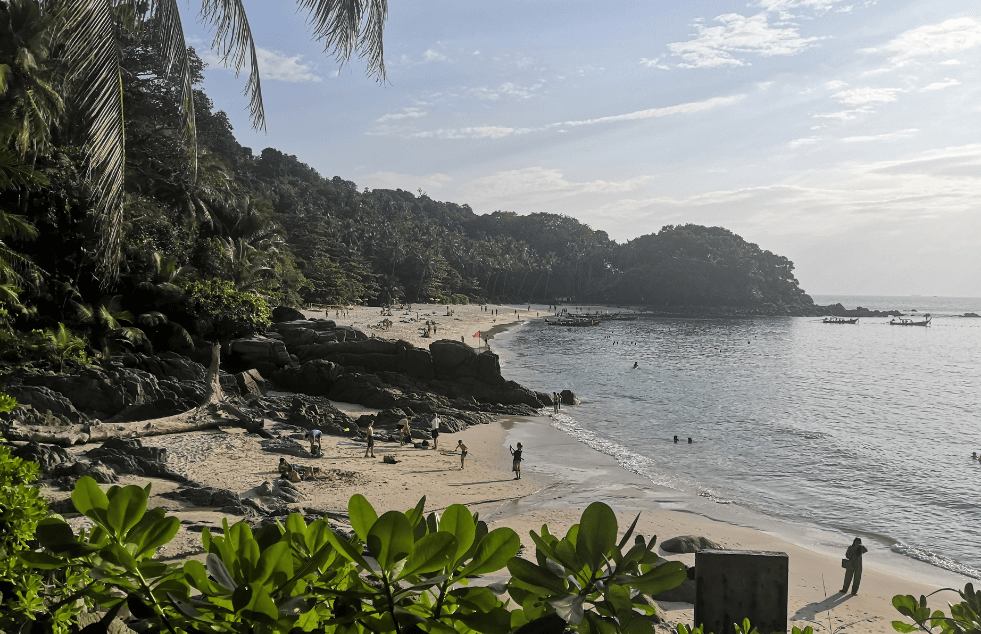
If you ask anyone what Thailand is famous for, chances are ‘beautiful beaches’ is going to be the answer. The country boasts a seemingly endless number of heavenly palm tree-lined beaches with soft white sand and calm turquoise waters.
Popular beach destinations like Phuket, Krabi, and Koh Samui have long been favourites among those seeking sun and sea. They are home to many fantastic beaches, complete with resorts, beach bars, and water sports.
If the ever-continuing development in these areas doesn’t sound appealing, don’t worry. You can still find quieter, more secluded beach stretches with hardly any people in sight there.
For travellers willing to venture off the beaten path, Thailand’s lesser-known islands like Koh Lipe, Koh Chang, and Koh Lanta are worth exploring. These destinations provide a more relaxed atmosphere, far removed from the bustling crowds, perfect for those seeking to get away from it all.
Thai Cuisine and Street Food
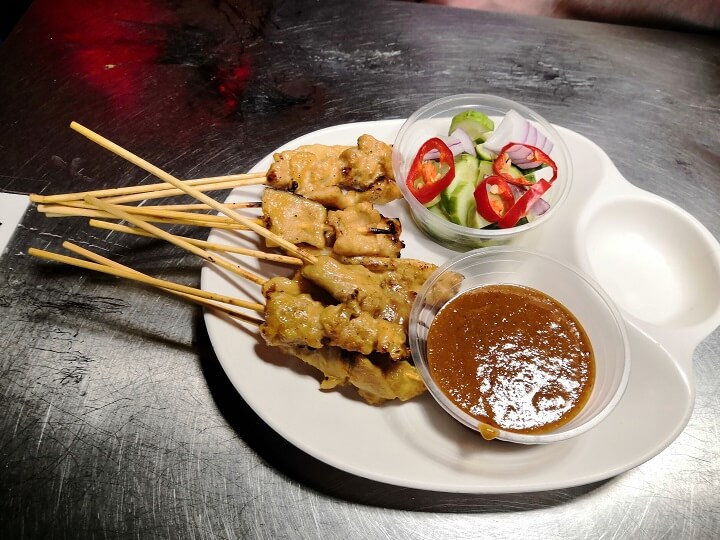
Thailand is also renowned for its delicious food. No matter where you go or what your budget is, you are sure to find delectable gastronomic delights.
Thai street food is one of the country’s most famous culinary experiences. It’s affordable, varied, delicious, and available almost everywhere. As you travel across the country, you will also encounter some regional food variations.
When it comes to street food, Bangkok’s Chinatown is my favourite place to go. Its main artery, Yaowarat Road, comes to life with numerous street food vendors each night. From skewers and dumplings to grilled seafood and noodle soups, there is something for everyone there.
Aside from street food, there are plenty of great cafes and restaurants that will delight foodies. If you are looking for a dining spot for a special occasion, Bangkok offers many Michelin-starred restaurants where you can experience the innovative work of local chefs.
Affordability for Tourism
Thailand is also famous for being an affordable travel destination, and there is certainly some truth to this. However, it’s always worth remembering that perception of price is relative to your personal financial context.
If you are coming from a wealthy country in North America or Europe, with a strong currency and high income, you will most likely find Thailand to be an affordable place to visit. This might not be the case for those coming from less wealthy countries, or for the locals themselves.
Ultimately, Thailand still offers hostel dorms for as little as US $6.00 per night, delicious street food for US $1.50 – $3.00 per meal, and affordable public transportation. Basic rooms in budget hotels start from as low as US $12.00.
Mid-range and luxury accommodation and experiences are also cheaper compared to their counterparts in the US and Europe. For example, you can book a night at a top-end four-star or entry-level five-star hotel for about $100.00 – $120.00 in Bangkok, a price that is unimaginable in London or New York.
So, if you are fortunate enough to live and work in a wealthier part of the world, your money is likely to go further in Thailand, allowing you to enjoy more luxuries than you might at home.
Endless Sunshine
Thailand is also renowned for its tropical climate, characterised by year-round sunshine and warmth. Indeed, the country doesn’t experience cold, snowy winters like other parts of the world, making it perfect for those who enjoy warmer temperatures.
However, it’s important to note that the Thai climate does vary throughout the year, and being aware of these variations can help ensure you have the best experience.
Thailand experiences three seasons: the cool season (November to February), the hot season (March to May), and the wet season (June to October), with slight regional variations.
During the ‘cool’ season, the average temperature is around 28°C (82.4°F), accompanied by low rainfall and humidity. Not surprisingly, this is the peak tourism season, suitable for both beach holidays and sightseeing.
The hot season sees temperatures rising above 30°C (86°F), with a slight increase in humidity. Outdoor activities in the afternoon heat, especially in cities like Bangkok, can be challenging, but beach areas remain appealing thanks to the sea breeze.
During the wet season, average temperatures are around 29°C (84.2°F). This period sees significantly more rainfall, with September and October being the wettest months.
Incredible Bangkok
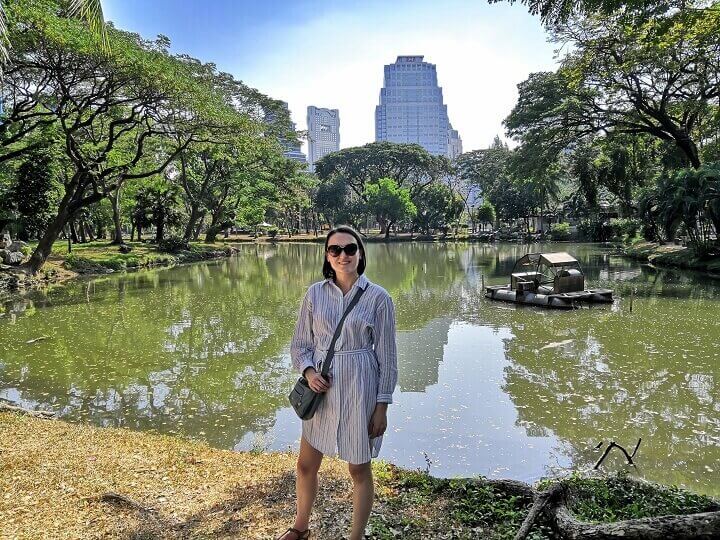
Thailand is famous of its capital city, Bangkok, which is a fantastic travel destination in its own right. You can visit it multiple times and always discover something new and exciting. As a city of over 11 million people, it is constantly growing and evolving, making it fascinating to observe its changes.
From incredible historic sites and majestic temples to delicious street food, vibrant nightlife, and exceptional shopping, Bangkok truly offers something for everyone. It is also a vast, chaotic city full of contrasts, where shanty towns hide in the shadows of dazzling skyscrapers.
Don’t worry, Bangkok isn’t just about glamour, craziness, and endless noise. Away from the crowds, the city boasts many tranquil corners in green spaces and along the canals, where you can experience its quieter, more mellow side.
If you are visiting Bangkok for the first time, check out these one-day and two-day itineraries that include Bangkok’s most iconic attractions and neighbourhoods. If you have more time, there is so much more to explore there.
Buddhist Temples
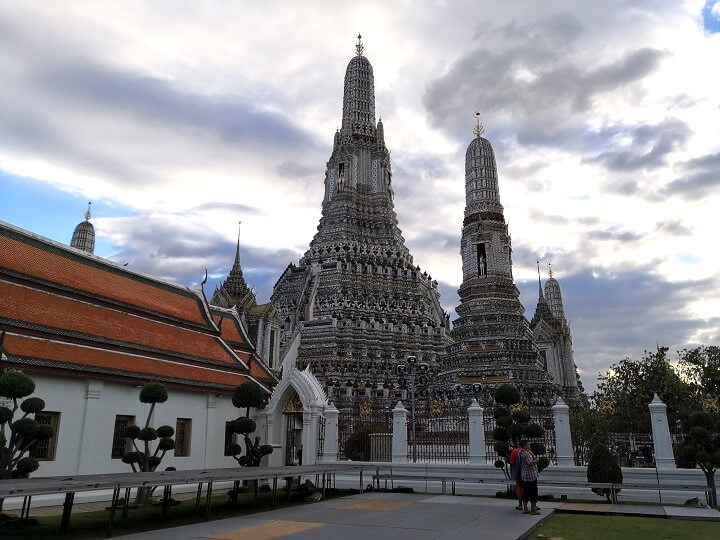
Buddhism is the predominant religion in Thailand, and most Thais practise it. It remains an integral part of daily life, so during your travels, you will encounter many expressions of it, including temples, home shrines, and monks in their distinctive orange robes.
One of the best ways to learn about Buddhism in Thailand is to visit a temple. They are easy to find, as the country is home to tens of thousands of them. Some are large and majestic, while others offer a much more intimate experience.
For those visiting Bangkok, the impressive Wat Pho and Wat Arun temple complexes are must-sees. The former is famous for housing the giant reclining Buddha figure, while the latter has become an iconic historic site due to its unique architecture.
If you are interested in ancient history, add the Sukhothai Historical Park and Ayutthaya to your itinerary. These sites are home to some impressive ancient temples, reflecting the religion’s long-standing presence and influence in the country.
Ultimately, no matter which part of Thailand you visit, chances are there will be a local temple you can visit for some tranquillity and reflection.
Paradise Islands
Thailand is also famous for its hundreds of beautiful islands scattered around the Gulf of Thailand and the Andaman Sea. Although the country is home to over 1,400 islands, most of them are uninhabited.
You can visit some of these islands on day trips, but staying for longer might be an issue as they lack infrastructure. Others may be completely off-limits as they are part of national parks.
Despite these limitations, there are plenty of great islands that travellers can explore. Often, the main reason for visiting Thai islands is the beautiful beaches that are commonly found there.
However, each island has its own vibe, personality, and level of development, making it exciting to visit as many as possible on your next trip. No matter what type of travel experience you’re after, you will find a Thai island that is perfect for you.
If you would like to visit an island with lots of activities, vibrant nightlife, and luxurious resorts, consider booking a trip to Phuket. For something a bit more off-the-beaten-track, head to the heavenly Koh Lipe or the tranquil Koh Yao islands.
Majestic Elephants
Another thing that Thailand is famous for is its majestic national animal, the elephant, which has significantly influenced Thai culture over the centuries. During your travels, you will encounter many depictions of it.
The local subspecies is the Indian elephant. Despite its cultural importance, it is now, unfortunately, an endangered species in Thailand, with only a few thousand, or potentially even fewer, left in the wild.
This decline is due to the growth of the human population and accompanying activities, often resulting in the loss of habitat for wild animals. Your best chance of seeing an elephant in the wild is at a national park, with Kui Buri National Park being a popular destination for this purpose.
Thailand is also home to several thousand elephants living in captivity. Many of these are still involved in the tourism industry, a controversial practice often involving poor treatment of the animals.
Thankfully, there is a shift towards more ethical elephant sanctuaries, where you can simply observe these majestic animals in their natural behaviour. It is recommended to stick to no-contact sanctuaries, as elephants are ultimately wild animals and for their welfare, it is best to simply observe them without interference.
Friendly People
The Thai people are renowned for their hospitality and friendly attitude, so much so that Thailand has been nicknamed the ‘Land of Smiles’.
My experience in the country is a testament to this reputation. Most people I’ve encountered during my travels in Thailand have been warm and welcoming. Some of my best memories are connected to my incredibly positive interactions with locals.
Granted, as visitors, we mostly deal with people employed in the tourism industry, and it is ultimately their job to make our experiences pleasant.
However, I feel that the Thais are especially good at making you feel welcome. Many individuals we’ve come across went above and beyond. I’ve found that this level of hospitality is not always the case in other countries.
It’s worth noting that, of course, there are Thai people who may not have your best interests at heart. Chances are, you will encounter scammers who will try to take advantage of you. However, these individuals represent just a small minority.
Thai Massage
No article on what Thailand is famous for would be complete without mentioning Thai massage. Although Thai spas offering traditional massages have popped up around the world, experiencing it in its country of origin is unparalleled.
Thai massage, with a history spanning over 2,000 years, combines elements of Ayurveda and traditional Chinese medicine. It involves rhythmic pressing, stretching, and bending techniques.
The therapist employs their hands, elbows, knees, and feet to apply pressure along the body’s energy lines, known as ‘Sen’. Thai massage is sometimes referred to as ‘lazy yoga’, as the therapist does most of the stretching work for you.
Promoting relaxation and easing muscle tension, Thai massage is a must-try experience in Thailand. You can find it almost everywhere across the country, from beaches to high-end spas.
Don’t hesitate to visit basic-looking massage parlours. They may lack fancy settings, but the therapists know what they are doing. With its relative affordability for tourists, you’re likely to want to return for more.
Royal Family
Thailand is officially a constitutional monarchy, with the King of Thailand serving as the head of state. The current ruling dynasty, known as Chakri, has been in place since the 18th century.
The Thai society deeply reveres the monarch, and as you travel around the country, you will encounter numerous images depicting the King and other members of the royal family. The Thais adhere to customs related to behaviour around the royals and their depictions.
Even if you hold republican views, it is advisable to refrain from criticising the royal family while in the country, as this could offend locals.
Speaking disrespectfully about the monarchy is also a criminal offence under Thai lèse majesté laws, some of the strictest in the world. Many individuals have got prison sentences for contravening these laws.
Interestingly, the younger generation is beginning to be challenge the status of the monarchy and the wider ruling class. However, any significant transformation of the current status quo appears to be far off.
Bustling Markets
Another cultural feature that Thailand is famous for is its markets, which remain a vital part of daily Thai life. As you explore different parts of the country, you will encounter many variations of these markets.
While you will find local markets almost anywhere, Bangkok is home to some of the largest and most impressive markets in the country. From wet markets teeming with fresh produce to the colourful and eclectic floating markets where you can shop from a boat, the city offers a market for every taste.
The Chatuchak Weekend Market in Bangkok, the largest in all of Thailand, offers an array of items from designer knock-offs and affordable clothing to street food, artisan crafts, and antiques. If you’re good at haggling, you’re sure to secure a bargain.
For something unique, visit the Amulet Market, located near Bangkok’s Grand Palace. This relatively small area is bursting at the seams with Buddhist amulets, lucky charms, and antiques. Even if you are not planning on buying anything, it’s worth just wandering around it for its special atmosphere.
Remember that truly valuable antiques aren’t cheap, so be cautious about what you’re buying and its origins before spending a significant amount of money.
Tuk Tuks
Tuk tuks are motorised rickshaws with three wheels that are used as a form of transport in Bangkok and in many other parts of the country. Although you can spot tuk tuks in other countries including Cambodia and India, they’ve become a rite of passage for many visitors to Thailand.
Tuk tuks are great for relatively short distances and can serve as an alternative to taxis. Although the cost will be about the same, tuk tuks are nimbler, so they may be able to get you to the destination faster.
Although popular with tourists, locals use tuk tuks in their daily life as well. A regular tuk tuk is designed to accommodate two to three passengers. I have seen more people cramming into one, but it’s not safe.
Tuk tuks do not have meters, so you need to agree a price beforehand. Don’t be afraid to haggle – the first price the driver names is normally inflated. I imagine tourists always end up paying more than locals, but since the price is so low by Western standards, I don’t worry too much about overpaying.
The price of a tuk tuk ride will ultimately depend on the distance covered. A short trip can cost you anywhere between 30 and 50 bhat (US $0.90 and $1.50), while a longer one may end up being in the region of 200 to 300 bhat (US $5.80 and $8.80).
Muay Thai (Thai Boxing)
Thailand is also famous for its national sport, Muay Thai, a form of Thai boxing. It is a traditional martial art and combat sport with roots dating back many centuries.
Muay Thai is also known as ‘The Art of Eight Limbs’ because it involves the use of eight limbs – fists, elbows, knees, and shins – during fights. This approach is supposed to mimic the weapons of war, transforming the body itself into a weapon.
Thanks to its appearance in movies and TV shows, Muay Thai is widely practised not only in Thailand but also around the world. It is recognised for its fitness and even mental health benefits.
Even if you don’t practise this sport, you can still experience the theatricality of Muay Thai by watching a fight on your next trip to Thailand. There are Muay Thai stadiums in pretty much every city.
However, Bangkok boasts some of the biggest Muay Thai stadiums in the country. Consider booking a spot at the Rajadamnern Boxing Stadium. Located a short distance from the infamous Khao San Road, it is the oldest and one of the most prestigious boxing stadiums in the city.
Luxurious Thai Silk
One of Thailand’s most famous exports is silk, making it a great souvenir option for your next trip. Thai silk is coveted worldwide for its luxurious textures and elaborate, colourful patterns.
Interestingly, it was Jim Thompson, an American entrepreneur, who played a pivotal role in reviving the Thai silk industry in the 1950s. Although Thailand had produced and exported silk for hundreds of years, the industry experienced a significant decline in the 19th and 20th centuries.
Thompson also led successful campaigns to popularise this fabric internationally. Thanks to his efforts, the Thai silk industry has become a strong component of the Thai economy.
You can find silk products in many places across Thailand. However, be cautious and remember that high-quality silk cannot be cheap. If a product seems like a ‘bargain’, it is likely not authentic.
I personally love the Jim Thompson stores located in many malls across the country. They sell beautiful and high-quality silk clothing, accessories, and homeware. Although some items are at a pricier end, you can still find relatively affordable smaller souvenirs to bring home.
If you love design, I also recommend visiting the Jim Thompson House Museum in Bangkok to learn more about this enigmatic figure and the Thai silk industry. I especially loved the interiors of the house, which blend traditional Thai style with an excellent collection of art and antiques.
Vibrant Nightlife
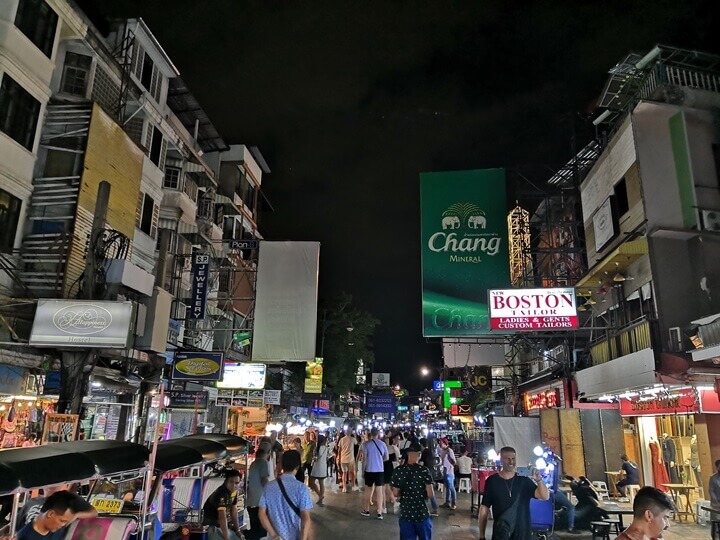
Thailand is famous worldwide for its vibrant nightlife and party scene. Whether you’re into cheap and cheerful backpacker bars, rowdy nightclubs, high-end rooftop bars, or relaxed beach clubs, Thailand has something to suit every vibe.
Bangkok, not surprisingly, is the epicentre of Thai nightlife. The city boasts Khao San Road, lined budget bars and souvenir stores, numerous nightclubs popular with both tourists and locals, jazz clubs, smart cocktail bars and ladyboy cabaret shows.
I particularly enjoy Bangkok’s rooftop bars, which are plentiful thanks to the constant addition of new skyscrapers. These tend to be on the pricier side, but they offer a delightful experience, allowing you to enjoy the stunning Bangkok skyline with a craft cocktail in hand.
Other popular nightlife destinations include Pattaya, Phuket, Koh Samui, and Chiang Mai. However, a word of caution: Pattaya and the town of Patong in Phuket have seedier aspects, especially in their main party areas.
Ladyboys
Speaking of ladyboys, they are a notable aspect of Thailand’s culture. Known as Kathoey in Thai, translating to ‘third sex’ in English, ladyboys are transgender women and are commonly seen in many touristy areas of Thailand.
Thai society is generally accepting of ladyboys, but there can still be some stigma attached to them. They often face societal barriers that may limit their access to education and career opportunities. However, the situation is gradually improving.
Thailand has a large ladyboy population thanks to the gender reassignment surgeries and other related procedures being relatively affordable in Thailand. This easy accessibility allows many to dramatically transform their appearance.
While you are likely to encounter ladyboys in many popular party areas, one of the best ways to see them is by attending a ladyboy cabaret show. A popular choice is the Calypso Cabaret located at the Asiatique Riverside Market in Bangkok, which is famous for its drama, choreography, and stunning costumes.
Medical Tourism
More recently, Thailand has also become famous as a destination for medical tourism. The country boasts high-quality private hospitals with excellent facilities and care.
Nowadays, you can easily combine a trip to a major tourist destination like Bangkok or Phuket with a comprehensive medical check-up or treatment. Overseas visitors often find that they can access these services at a much lower cost than back in their home country.
The Thai medical tourism industry is likely to grow considerably in the future. I don’t know much about other countries, but in the UK, where I live, healthcare is under immense pressure with long waiting times, and the situation is likely to worsen.
This means that people will be looking for alternatives, and Thailand offers one. It has become particularly popular for routine joint and hip procedures, dental care, and orthopeadic treatments, although you can address many other health issues can there.
It’s worth noting that most Thais can’t afford to access these medical options, as they are mostly private. Medical tourism encourages a brain drain from the state system to the private sector and drives up private healthcare costs, making it less accessible even for wealthier locals.
I think the demand for medical services in Thailand will only grow, but hopefully, the Thai government can find ways to channel the increasing income from foreign visitors into improving the quality of state healthcare for the locals.
Full Moon Parties
I’ve already touched upon Thailand’s vibrant nightlife and its diversity. However, one aspect that has become an icon of hedonism in its own right is the Full Moon Party.
A rite of passage for many young travellers visiting Thailand, the Full Moon Party began on the island of Koh Phangan in the 1980s. Although it originally started as a small and intimate event, it now attracts thousands of visitors with each full moon.
The party lasts all night long and boasts a wild atmosphere featuring electronic music, endless flows of cheap alcohol, colourful lights, body paint, and even fire rope jumping. It’s no surprise that people from all over the world travel there for what they hope will be the night of their lives.
Other locations across Thailand, such as Koh Samui and Phuket, have tried to replicate the success of the original Full Moon Party. However, none match the scale or the reputation of the one on Koh Phangan.
Questionable Animal Experiences
Thailand is home to unique wildlife, including elephants, tigers, sun bears, and gibbons, which travellers can spot in national parks. Unfortunately, there are many instances where wild animals play the role of a tourist attraction and provide entertainment, often leading to animal mistreatment.
Thailand is not unique in its unethical practices – this is a problem in many tourist-dependent locations. However, given Thailand’s immense popularity as a destination, the dark side of its animal tourism have come under the spotlight.
On your next trip to Thailand, make sure to prioritise ethical animal experiences and avoid those implicated in cruel practices and mistreatment. Elephant rides are harmful to these majestic animals and you should avoid them.
It’s best to steer clear of any attraction that offers close contact with wild animals, whether it’s elephants, tigers, or others. Wild animals are unpredictable, and their keepers often employ malpractices to keep them docile around humans.
Instead, direct your tourist spending towards no-contact sanctuaries and conservation projects working to protect Thailand’s unique wildlife, which is under threat from human development.
Over Tourism
Another not-so-positive thing Thailand is famous for is over tourism. The ‘Land of Smiles’ attracts tens of millions of international visitors annually. While this has been a crucial economic driver, it has also led to Thailand becoming a victim of its own success in some ways.
Popular destinations like Phuket, Krabi, and Pattaya are considered some of the most overcrowded in the world, with tourists significantly outnumbering locals.
An increase in tourism has also affected many other places. Notable locations like Maya Bay, made famous by the movie ‘The Beach’, have had to close periodically to recover from the adverse effects of tourism.
Overtourism results in crowded beaches and attractions, rampant development that can harm the very beauty that attracts visitors, loss of natural habitats, rising prices for locals, and even worker exploitation.
One way to mitigate this issue is to travel to lesser-visited areas. Thailand still has many such places, and your tourism spending can help support local economies.
Sex Industry
Although not a desirable association for the country, the reality is that Thailand is famous for its deeply entrenched sex industry. Despite prostitution being officially illegal, the industry is so lucrative that the government often turns a blind eye.
As you travel around Thailand, you are likely to notice its presence through go-go bars, sex shows, and dubious massage parlours. Certain areas have become hotspots for the industry.
Bangkok’s red-light districts such as Soi Cowboy, Nana Plaza, and Patpong have become tourist attractions in their own right. Places like Pattaya and Patong in Phuket are also notorious for this. If you visit these areas, expect that a sex worker may approach you.
In theory, what consenting adults do is their own business. However, the industry has a dark side, including evidence of the presence of minors and human trafficking.
Sadly, many individuals from poorer regions of the country join the industry because there are no other lucrative employment options. The only way for the government to reduce the supply of workers in the industry is by investing in economic development so people can take up other gainful employment opportunities.
No matter how you feel about this, this is not something that’s going to go away, and it is part of modern Thailand. I’ve found that by visiting areas not associated with the industry, you can largely avoid its most visible manifestations.
Crazy Traffic
Thailand has a reputation, confirmed by many visitors, for its crazy and chaotic traffic. Indeed, from the congested highways of Bangkok to rural roads where rules seem non-existent, road travel can be frustrating and sometimes downright dangerous.
Unfortunately, the country has one of the highest road accident rates in the world, leading to thousands of fatalities. Most deaths involve motorbike riders, often from less advantaged strata of society, and they frequently occur on rural roads.
Why does this happen? Despite the Thai government’s repeated declarations about reducing road fatalities, little progress has been made. Road rules are poorly enforced, fines are low, drivers commonly disregard speed limits, and many roads are poorly maintained. Drunk driving is also a significant issue.
Currently, there is little public demand for improvements in this area, so significant changes in the near future seem unlikely. This poor road safety record is one of the main reasons tourists are advised against driving in the country.
Scooter riding is popular, and Thais make it look effortless. However, if you decide to ride a scooter while in Thailand, ensure your insurance covers this activity. And, for goodness’ sake, wear a helmet.
Final Thoughts
So here we are, these are some of the many things Thailand is famous for, from positive aspects to the more questionable ones. Personally, I believe the ‘Land of Smiles’ should absolutely be on your bucket list.
If you are already planning your trip, check out these guides to two fantastic destinations in Thailand, Bangkok and Phuket, as a well as a comparison guide between the two. The capital has so much to offer, whether you are there for a week, two days or just 24 hours.
Phuket is an excellent beach destination that also offers a wide array of activities sure to delight solo travellers, families and couples alike. If you are heading there in December, which is one of the best times to visit the island, check out this guide on what it’s like to visit Phuket at that time of the year.
Ultimately, no matter where you go in Thailand, I’m confident that you will have a wonderful trip.
FAQs: What is Thailand Famous For?
There are numerous reasons why people visit Thailand, including its beautiful beaches, tropical climate, delicious food, fascinating culture, and excellent shopping opportunities. It is also an affordable destination where many tourists find that their home currency goes much further.
The Thai people are known for their hospitality: they are open and welcoming to visitors. The friendliness of Thai people is the reason why Thailand has been nicknamed the Land of Smiles. In my personal experience, this is completely true. I’ve found my interactions with the Thais to be overwhelmingly positive.
Yes, it is completely OK to go to Thailand alone, and many people do it. It is a safe destination, with great tourist infrastructure and a wide range of things to do for different interests. Chances are, you will meet many other solo travellers while visiting Thailand.
Although Thailand is safe for tourists, you still need to be as careful as you would be at any other destination or even at home. Regular precautions apply: be aware of your surroundings and keep an eye on your belongings, avoid unlit areas at night, and don’t leave your drink unattended. Also, trust your gut – if a situation feels dodgy, politely remove yourself from it.
Enjoyed this article on what Thailand is famous for? Bookmark or pin it for later.
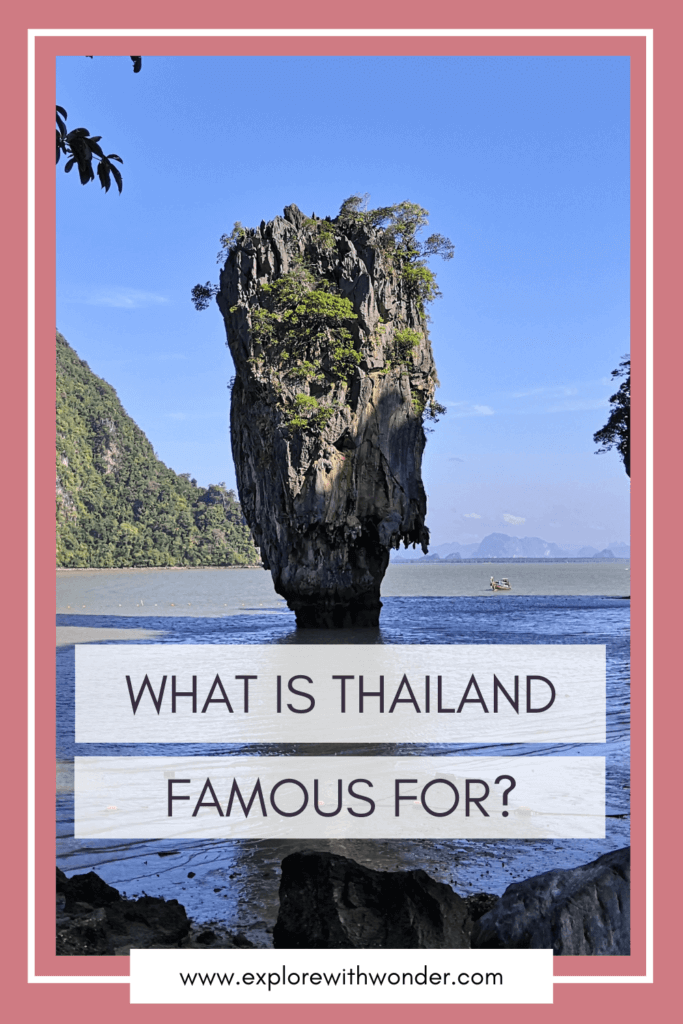
Related Reads: Thailand
- Is Thailand Worth Visiting in 2024? 17 Best Reasons to Visit Thailand
- Why Is Thailand So Cheap? Cost of Travel to Thailand in 2024
- Is There Uber in Thailand in 2024? Everything You Need to Know
- Does It Snow in Thailand? Everything You Need to Know
- Phuket or Bangkok: Which Should You Visit?
- Is Bangkok Worth Visiting in 2024? 17 Best Reasons to Visit Bangkok
- Best Areas to Stay in Bangkok in 2024
- Is Phuket Worth Visiting in 2024? 10 Reasons to Visit Phuket
- 24 Hours in Bangkok: The Ultimate Itinerary
- 2 Days in Bangkok, Thailand: The Definitive Travel Itinerary
- Where to Stay in Phuket for Couples: The Best Areas and Hotels
- Phuket in December: Everything You Need to Know in 2024


